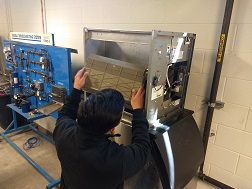(HUTTO, Texas) – Today’s heating, ventilation and air conditioning technicians need to know more than basic electrical theory and refrigeration processes. As technology evolves, so does the need to be familiar with how smart technology is being used in HVAC systems.
Curtis Christian, a Heating, Ventilation and Air Conditioning Technology instructor at Texas State Technical College’s Williamson County campus, said the students who are adept at computers and electronics are going to have a hiring advantage.
“There is a lot of detailed work,” he said. “You have to get all the sensors and get everything lined up, and everything has a little code to go with it.”
Some of the technology being seen in the industry includes smart sensors that can communicate with downloaded phone apps and smart thermostats. Employers can provide training through outsourcing or equipment manufacturers.
Christian said the use of smart technology is evolving from the wiring work that technicians have done in the past. He said smart technology is being used more in new and remodeled construction.
“Now they are able to do it using a router and wireless technology,” he said. “You can put a sensor in a room and a controller somewhere else and dispense with all the wiring.”
The HVAC Technology program receives input from its state advisory board made up of industry personnel who give advice on how to adapt the curriculum to what is occurring in the workplace.
“They are interested in having guys that can understand and troubleshoot,” Christian said.
The number of jobs for heating, air conditioning and refrigeration mechanics and installers is projected to increase to 414,200 workers through 2028, according to the U.S. Bureau of Labor Statistics. It credits the increase in workers to growth in modernized climate-control systems. The Austin area had more than 1,800 HVAC technicians in May 2018, according to the labor bureau.
TSTC’s HVAC lab will undergo a makeover this year, including the installation of a variant refrigerated flow (VRF) digitally-controlled heat pump.
“It is made by Toshiba, so it has sensors that you would not find on a regular residential HVAC system,” Christian said. “VRF takes heat and puts it in another room. You still have the outdoor unit, and it ups the efficiency and is popular in new construction and Leadership in Energy and Environmental Design (LEED)-certified construction.”
For more information on Texas State Technical College, go to tstc.edu.
